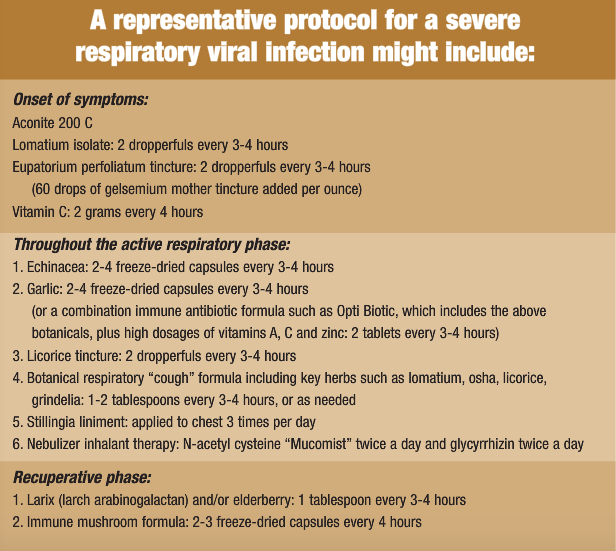Dr. Ancharski
Many experts predict that viral disease will be the key focus in medicine in the decades ahead. Much of the population is unaware of the influenza pandemics that devastated this country and others in the first half of the last century. With the advances in vaccination and the promise of antiviral drugs in the latter half of the 20th century, a false sense of security developed. The human immunodeficiency virus (HIV) changed that complacency.
The medical community also gained a new respect for the powerful role of viruses in chronic disease, from chronic fatigue syndrome and herpes to hepatitis C and other possible viral triggers to cancer. While these types of chronic viral conditions are becoming more prevalent, conventional treatment options are limited. When outbreaks of Ebola, Hanta, West Nile, Dengue Fever and even monkeypox viruses occur, community and world health professionals scramble to respond. Biological and genetic manipulations of viruses in both commercial and biological weapons laboratories potentially complicate an already worrisome situation.
Most recently the severe acute respiratory syndrome (SARS) virus has appeared in Asia, and even the most conservative medical experts are concerned. The SARS virus is classified as a new coronavirus, named for the halo of protein spurs that surround the viral envelope. The role of an accompanying paramyxovirus is still under investigation. Initial symptoms of SARS are a fever greater than 100.4ºF and flu-like symptoms, including headache and body aches. After three to seven days, a dry cough develops and is accompanied by rapidly increasing shortness of breath and a severe pneumonia. It spreads through person-to-person contact (i.e., hands to mucous membranes, infectious droplets, fecal contamination) and ominously affects healthy individuals, as well as the young, old and infirm. There is a greater than 50% spread to close contacts (i.e., family, healthcare workers) and 30-40% of fully developed respiratory cases require intubation and mechanical ventilation, while 50% of patients develop leukopenia, lymphopenia and thrombocytopenia. Creatine kinase and hepatic transaminases are often dramatically elevated. The fatality rate is unusually high, particularly when timely intensive supportive care is not available.
Viruses are chiefly spread from person to person via respiratory or enteric routes. However, there are many categories of viruses, some having insect vectors and others apparently jumping species from primary to secondary (human) hosts. Viruses are the smallest of parasites, not even consisting of cells capable of life on their own. They consist of a nucleic acid core of DNA or RNA and a protein, or sometimes a lipid outer covering. They are wholly dependent on host bacterial, animal or plant cells for reproduction. The DNA core material enters and infects susceptible cells.
Our Best Defense against Viruses
We must learn more about how our bodies and other animals and plants have evolved defenses against viruses as well as the ability to coexist with surrounding organisms. We know that many plants have developed specific antibiotic protective mechanisms. The basic mechanisms of our immune system, including which factors induce host susceptibility and immune suppression or enhancement, must be better understood and subsequently utilized. Maximizing the effectiveness of our own cellular immune responses (e.g., macrophages, WBCs, lymphocytes and interferon) is ultimately our best defense against viruses. While positive advances continue to occur in the areas of viral detection, vaccinations and testing of antiviral drugs, the ability of viruses to adapt to and utilize their host environment, including mutation, often outpaces these advances.
Standard medicine continues to try to duplicate its somewhat successful strategies in the war against bacteria to combat this new viral threat. However, most of the antiviral drugs developed have been clinically disappointing, with the exceptions being the HIV cocktails, and some limited applications for interferon and acyclovir class medicines. Vaccinations have shown varying degrees of success for a limited number of viruses, but may be dangerous to some and may further accelerate viral adaptations.
Many conditions in today’s world foster an increased risk for new viruses appearing, or for disastrous outbreaks of known viral diseases. Millions live in poverty in overcrowded, polluted cities, and overall stress is on the rise, while dietary, air and water quality is diminishing. Additionally, travel is truly global and many populations live in close proximity to (and even eat) known animal viral hosts such as pigs, birds, rats and monkeys. Such conditions predominate in third-world regions such as Africa, Asia and Latin America, and they must be addressed on a public health level at least as aggressively as vaccination and drug research. Of particular current concern is a pending cyclic appearance of pandemic “bird flu,” with predicted fatalities in the hundreds of thousands worldwide.
Natural Medicine Unexplored
An area of vast unexplored potential is the efficacy of alternative or natural medicine in viral disease. Yet to be explored, for example, are variations on the conventional vaccination and antiviral drug approach (such as homeopathic nosode and viral remedies) and natural antiviral substances, including traditional botanical medicines.
In a study cited in the June 14, 2003, issue of The Lancet, German researchers found that glycyrrhizin, an active component of licorice root, was significantly more virotoxic (killed and/or stopped reproduction of the virus) against the SARS virus (in the laboratory) than four leading antiviral drugs, including ribavirin (which had no effect). Showing additional promise is the role of immune enhancing strategies, ranging from general and specific nutrient substances to complete alternative medical systems (e.g., naturopathic, Chinese, Ayurvedic or simple indigenous systems), which center on cleansing and detoxification, restoring balance and boosting the vital force.
Naturopathic physicians have successfully treated severe annual flus, stubborn respiratory viruses, hepatitis C, chronic fatigue syndrome (with and without identifiable viruses such as EBV and CMV), chronic herpes and HIV. Similar strategies should impact SARS (although it must be appreciated that there are no substitutes for preventing its spread, including isolation).
The following specific natural medicines have shown efficacy in viral disease:
Botanical antivirals (in order of potency):
lomatium, chaparral, licorice, garlic, osha, Echinacea, lemon balm, St. John’s Wort, goldenseal, sanguinaria, oregano
Medicinal mushrooms with immunomodulating activity (often containing large molecular weight polysaccharides):
maitake, shiitake, reishi, zhu ling, cordyceps
Botanicals with strong immune enhancing effects (also containing large molecular weight polysaccharides):
Echinacea, larch tree, astragalus, aloe vera, elderberry
“Flu onset” botanicals:
lomatium, eupatorium perfoliatum, gelsemium (as an activator utilized in low dosage; i.e., a few drops)
Adaptogens:
Siberian ginseng, garlic, ginger, licorice
Additional botanicals for chronically debilitated patients:
avena (nutrient), baptisia (immune boosting), stillingia (respiratory)
Antioxidant vitamins:
mixed carotenoids, vitamin A (particularly important to enhance mucous membrane defenses), vitamin C, vitamin E (mixed tocopherols and tocotrienols), selenium, alpha lipoic acid, CoQ10
Antioxidant botanicals (which are also liver protective):
milk thistle, turmeric, ginger, ginkgo, plus fruits and vegetables with high flavonoid content
Respiratory botanicals (includes demulcents, expectorants, bronchodilators, mucolytics, antitussives and antibiotics):
grindelia, licorice, lobelia, lungwort, pleurisy root, mullein, osha, lomatium, slippery elm, ephedra, sanguinaria, coltsfoot, elecampane, wild cherry, horehound, fennel, white pine, poplar, drosera, yarrow
Botanicals for gastrointestinal viruses:
artemesia annua and goldenseal (acute), garlic and cat’s claw (chronic)
Nutrient intravenous therapy:
vitamin C, hydrogen peroxide
Nebulizer inhalant therapy:
- N-acetyl cysteine, glycyrrhizin, hydrogen peroxide
- Specific symptom-based single and combination homeopathic remedies
- Hydrotherapy
- Fasting

The roles of increased rest and fluids (water), high-quality organic foods and stress reduction must not be underestimated in both the acute and chronic treatment regimens. Lower doses of the same medicines can be used as preventive measures during viral outbreaks.
 Dr. Ancharski graduated from NCNM in 1979, followed by the very first naturopathic residency (in obstetrics and family medicine). His teachers included such pillars of the profession as John Bastyr, O.G. Carroll, William Turska, R. Noble, A.W. Kuts-Chereaux, William Babnick, Bill Mitchell, John Ettinghausen and Jeffrey Bland. He has served as clinic director at NCNM, and as a clinical professor at both NCNM and SCNM. He co-founded Eclectic Institute and founded BioGreen-One Earth, One Body, both centers of research and development of nutritional and botanical medicines. He had an extensive OB/family practice in Portland, Ore. (establishing the Natural Childbirth and Family Clinic) as well as a renowned nutritional/botanical medicine practice in Tucson, Ariz. (the White Dove Clinic). Dr. Ancharski currently maintains a rural general practice on the north shore of Kaua’i, Hawaii.
Dr. Ancharski graduated from NCNM in 1979, followed by the very first naturopathic residency (in obstetrics and family medicine). His teachers included such pillars of the profession as John Bastyr, O.G. Carroll, William Turska, R. Noble, A.W. Kuts-Chereaux, William Babnick, Bill Mitchell, John Ettinghausen and Jeffrey Bland. He has served as clinic director at NCNM, and as a clinical professor at both NCNM and SCNM. He co-founded Eclectic Institute and founded BioGreen-One Earth, One Body, both centers of research and development of nutritional and botanical medicines. He had an extensive OB/family practice in Portland, Ore. (establishing the Natural Childbirth and Family Clinic) as well as a renowned nutritional/botanical medicine practice in Tucson, Ariz. (the White Dove Clinic). Dr. Ancharski currently maintains a rural general practice on the north shore of Kaua’i, Hawaii.


